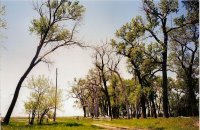Growing up in the Nebraska Sandhills
Back in the 1950's and 1960's, I attended a one-room country school like many ranch kids of Nebraska did (and still do!) The little stucco schoolhouse (Duff Valley District 4) was about two miles from our home.
My parents drove us to school in the morning, but in the afternoon we often walked home. The first mile was a county road. It was shaded by tall cottonwood trees until the bridge over Bloody Creek. After that, the road was unshaded and very sandy until we reached our mailbox.
 |
| The ranch road, as seen a few years ago from the corner where our mailbox stood. In my childhood, this grove of tall cottonwoods was in its prime. |
The county road turned north at our mailbox, but we turned south onto our ranch road. After the first gate, we cut across the meadow and through the milkcow pasture. This route involved crossing two barbed wire fences, but it was worth it because of the distance it cut off.
We dawdled along the way when the weather was nice. I had trees that I liked to visit. One was a squat, prickly, cedar tree that grew along the roadside. I admired its silver berries and tasted the aromatic sap that oozed from its trunk. I was also fond of a big cottonwood that had fallen over in a storm but was still living. It was interesting to climb onto its trunk and walk through its branches.
If the bookmobile had visited our school recently, I clutched my lunchbox with one hand, held my book with the other and plodded along, lost in a story. Cars rarely came down the road, so I didn't worry about traffic.
Sometimes there were Brahma bulls in the Hollenbeck pasture. If so, my brother had to stay with me until we had passed them. He didn't like my dawdling, so he got a little switch and walked behind me to hurry me along. I don't remember him hitting me, but he did "encourage" me.
I regret to say that I may have used the same technique sometimes to hurry my little sister down the road a few years later. Sorry, Charlotte. (I have to confess this, or she will think I have painted an incomplete picture of our walking-home experiences.)
In the fall, we shuffled through dry brown leaves that had fallen from the cottonwood trees. In the ditches, cattails and milkweed pods invited us to pick them. Sandburs gathered in our shoelaces and the seeds of the dry prairie grasses stuck in our socks when we cut across the meadow and pasture.
On winter days, we walked fast. We were glad to turn south onto the ranch road and have the wind at our backs instead of across our faces. Our hands ached with cold before we got home, despite our mittens. Once I made the mistake of running warm water over my frozen hands to warm them. Don't try that-- it hurts!
If a winter storm was blowing in, someone always came to pick us up from school. Our teachers wouldn't have let us walk home in dangerous weather, anyway. Every native Nebraskan has heard the fearful story of the Schoolchildren's Blizzard and respects its lessons.
In the spring, the cottonwoods bloomed and made their little strings of cotton balls. One afternoon, my sister and I picked cottonwood blossoms and filled Laura Zlomke's mailbox with them. We thought it would be a nice surprise for her. (Laura was a widow lady who lived with her bachelor brother about 1/2 mile west of the school.)
When the frost went out and the last snowbanks melted, Bloody Creek ran full. A dirty white foam formed on the water's surface and collected in the weeds. It was obvious to me that the waters of Bloody Creek were at high tide. That's why the water was foamy, like the Tide suds in my mother's washing machine. (It made sense at the time.)
We threw leaves, shreds of bark, and little sticks into the water and watched them float under the bridge, out the other side, and away through the "tides" of Bloody Creek. We knew a little poem about boats that my mother liked to recite. She had learned it when she was a child. " ... Boats of mine a-boating— / When will all come home?"
Spring rains filled the ditches and flooded the meadows. When I waded too deep, the water pushed the tops of my overshoes against my shins just before it flowed inside them. If I carefully retreated when I felt my overshoe tops go wavy, my feet might stay dry. When the water spilled in, the rest of my walk home was squishy and squeaky.
When we finally arrived home, we sometimes found that Mama had left each of us a list of chores to do. She often went with my dad to help him do various things on the ranch, and the lists were intended to keep us out of trouble if we got home before she did. Those lists were what I really intended to write about when I started this, but I've dawdled along the road so much that I think that essay will wait for another day.
No comments:
Post a Comment